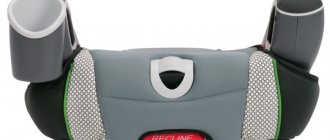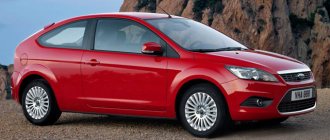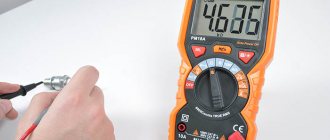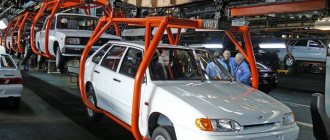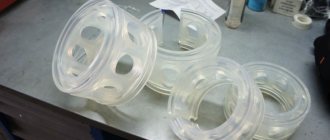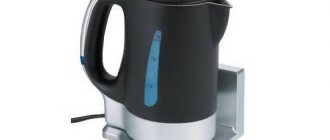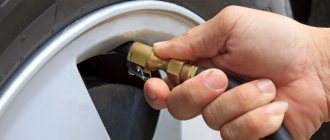Car manufacturers spend huge amounts of money to improve the safety of their creations. New designs are invented, perfect systems are developed, and tests are carried out. One such invention is active head restraints. These structures are located at the top of the car seat. To understand the principle of their operation, it is necessary to make a short digression and make an excursion into the physics course. An accident is dangerous not because of the impact itself, but because of the law on conservation of energy. By inertia, the body continues to move in the direction given to it, then receives an impulse and quickly changes its movement. There are obstacles along the way. If they are soft, then a person will not be injured in a collision. Such obstacles are the seat belt and airbag.
Purpose and benefits of active head restraints.
When the human body receives an impulse to suddenly stop or suddenly change movement, a powerful impulse passes through the spine. Some of it is lost along the way, but the neck still suffers greatly from the impulse that reaches it. At this moment, the active systems of the chair are activated due to the displacement of the body, which activates the lever. The headrest will move towards the head and take on a significant part of the impulse. A short shift will allow the structure to absorb this energy, after which support for the head will return.
What are active head restraints?
Active head restraints are a component of the vehicle's passive safety system. Externally, they are no different from standard ones, although their internal structure is completely different.
To understand the basic principles of their operation, let’s imagine the following situation. You are driving your car when suddenly another vehicle hits you from behind. The bodies of people in the car, under the influence of inertial forces, begin to shift sharply backwards. The necks and heads of passengers receive serious acceleration, as a result of which they begin to rapidly move towards the headrest. However, at this moment, the head restraints themselves suddenly sharply press against the heads of the crew members and, accelerating along with them, gradually reduce the speed of their movement. As a result, heads do not experience a strong impact with the head restraints, and people's necks remain intact.
As you probably guessed from the example we gave, the task of active head restraints is to provide lightning-fast support to the heads of passengers to gradually reduce their acceleration.
An additional positive side of using automatic head restraints is the fact that they do not require any additional adjustments. Let us remember that their stationary counterparts force the driver to periodically adjust their height. Active systems do not need this. They are calculated on the average anthropometric data of a person. Additional adjustments will be needed only if the seat is occupied by either a short person who is overweight, or, conversely, a tall passenger with a thin build.
Have you adjusted your headrest?|
A headrest in a car is not only for convenience, but also for safety. For two years now, the Swiss Association of Insurance Companies ASA has been trying to draw drivers' attention to the fact that an incorrectly installed head restraint can cause a fracture or paralysis of the spine during a road collision. It looks like her calls have borne first fruit. The ASA said on Thursday that the national "Head Restraint Protects" campaign it launched two years ago together with the Swiss Office for Accident Prevention (bpa) and the Foundation for Road Safety (FSR) has produced positive results. According to a survey conducted by bpa experts during the campaign, one in twelve drivers adjusted their head restraints in accordance with expert recommendations. “From 2007 to 2009 we surveyed more than 1,000 people every year,” explained Uwe Evert, author of the statistics. According to these data, 45% of drivers in 2007 drove with their head restraints at the correct height. Thanks to our safety campaign, 56% of drivers now have their headrest adjusted to the same height as their head. Heinz Roth, responsible for prevention measures and health campaigns at the ASA, clarified: “Our goal has been achieved. I am personally very pleased that we were able to convince so many motorists to correctly configure the seatback headrest position. Only in this position does the headrest effectively protect the neck and head.” The Swiss Association of Insurance Companies estimates that approximately 300 spinal fractures and paralysis have been avoided thanks to the Headrest Protects project. In addition to the number of lives saved, success is also measured in monetary terms: 10 million francs were saved on the costs of rescue and medical care for victims, as well as disability benefits - a consequence of injuries to the cervical spine as a result of violent collisions. For comparison: approximately 4,500 such accidents occur per year,” said Uwe Evert. The face and logo of the campaign, now ended, was Swiss racing driver Christina Zurer, demonstrating with her hand on her head how high the head restraint should ideally be to effectively protect the driver in a collision.
What position of the headrest is considered correct? Just a few simple gestures are enough to adjust the backrest of the chair. The main thing is to follow two basic rules:
— the top edge of the headrest should be at the same height as the top of the head. In the event of a sudden collision, the body is thrown forward and upward, and if the head restraint is not at sufficient height, the head can be thrown back far above the level of the head restraint. — the distance between the headrest and the head is also important: it is necessary that the headrest touches the back of the head. If it is located too far, you can get an injury to the back of the head when you push it hard and move your head back.
Before pressing the gas pedal, check the position of the seat and head restraints - both for the driver and passengers.
Some head restraints may not fit individually in configuration. Thus, problems with the correct adjustment of the standard headrest may arise for people taller than 1.80 meters. The Swiss Office for Accident Prevention recommends the use of an “extension” for head restraints: such devices are sold in specialized stores and cost about 80 francs.
It is also useful to know about such a design as an “active head restraint”: this is a system - mechanical or electrical - that reacts to a push and moves the head restraint higher and closer to the back of the driver’s head, protecting the cervical spine from impact. Similar developments are offered, for example, by Nissan, Saab (SAHR system), Volvo (WHIPS) and Mercedes (Neck-Pro). At the same time, the back of the chair itself moves in Volvo to minimize the load on the spine.
Finally - or rather on the road - a few simple tips that we sometimes (and in vain!) neglect: - maintaining a distance from the car in front significantly reduces the risk of collisions; — while driving you are protected not only by a seat belt, but also by a correctly adjusted headrest and seat back; — check the position of the head restraints before each trip; — when buying a car, pay attention to the ability to fix the position of the headrest, and also inquire about installing an “active headrest”. — at a traffic light, hold down the brake pedal and watch the traffic in the rearview mirror without turning your head. This will allow you to prepare for a possible shock in advance. If you notice that the car behind you will not be able to brake in time, press your torso firmly against the back of the seat and your head against the headrest.
Detailed information and a film about the importance of the correct position of the headrest can be found on the website www.appuis-tete.ch
Swiss Association of Insurance Companies
What types of active head restraints are there?
According to their design, active head restraints are divided into two types:
- mechanical,
- electric.
Mechanical active head restraints
The design of mechanical devices is quite simple. A special lever is built inside the chair, which is connected to the headrest. During an emergency, the person’s body is pressed tightly against the backrest, exerting pressure on it. This causes the head restraint to move forward. When the force interaction between the human body and the seat back decreases, the spring returns the headrest to its original position. The stronger the blow to the rear of the car, the stronger the person will be pressed into the seat, and the faster the system will operate. Electric active head restraints
The electrical headrest circuit is noticeably more complex. It includes shock sensors, a control unit and a lever mechanism that turns the headrest into motion. The main part of the drive device is the squib. Impact sensors are located on the rear of the vehicle. They constantly send signals that are processed by the control unit. In the event of a critical situation, he, focusing on the strength and direction of the impact, activates the head restraints, adjusting their activation force.
The efficiency of electrical systems is noticeably higher than that of their mechanical “brothers”. A more complex device also determines a noticeable price difference between them. To be fair, let’s say that the presence of even mechanical active head restraints in a car significantly increases the overall level of vehicle safety.
Problems encountered with active head restraints
- Having undeniable advantages, automatic head restraints can also cause some trouble during use. These include complaints from motorists regarding the operation of the lever mechanism even with slight contact of the human body with the back of the seat. As a result, the crew members receive a rather heavy blow from the headrest.
- Often the mechanism itself causes certain inconveniences. Its hard parts interfere with the back of the driver, who cannot find a comfortable seating position. In the case of short-term trips, this does not interfere too much, but if there is a long intercity trip, the discomfort will be simply colossal.
- Dealership centers are in no hurry to recognize such situations as warranty cases. Their main motivation is that all the cars presented have similar problems. Car owners have to get used to it or fix the defects themselves.
- Another common problem is the failure of clamps or other components of the drive mechanism. Typically, this is due to poor quality materials used during the assembly process. Drivers with these defects should go straight to the “officials”. Dealers have no right to refuse free repairs in such a situation.
What's the end result?
When assessing the need to install active head restraints in a car, we will rely on two factors: their price and statistics on neck and head injuries during road accidents. Depending on the car model, the cost of installing such head restraints is 2-5 thousand rubles. According to statistics, they prevent vehicle passengers from getting injured in 30% of accidents. Are you ready to save these “pennies” at the cost of the lives of team members? We think that there can be no other options except, of course, installing these systems. If it is technically possible, install it and don’t hesitate! Believe me, to preserve life and health, active head restraints will not be superfluous.
When and why should headrests be removed?
Initially, the headrest was created not only to provide convenience while driving a car, but also for safety.
In particular, it is the headrest that supports the neck and head during a collision and, in general, any sudden deviations of the head during movement. Thus, if something similar is observed, then the driver and passengers have the opportunity to better preserve their own body than in a situation where there are no head restraints.
That is why further consideration of the situation when the head restraints can be removed does not involve removing them from the driver's seat. There should always be a headrest there, this is an indispensable rule of safety and normal driving. On the other hand, there are situations that require the possibility of removing the head restraints.
When head restraints are not needed. Attention should be paid to the fact that their presence is not a formal requirement, but is also included in the current traffic rules. The absence of a headrest, as well as a seat belt, implies a fine.
The situation may be when only one person is traveling in the car. In particular, if such a car is a crossover or hatchback, then a situation with quite difficult rear visibility is often observed. The reason for this lies in the design of some modern cars, which position the headrests of the rear sofas in such a way that it becomes quite difficult to view the entire rear window.
This factor of reduced visibility can especially manifest itself in situations of poor visibility or difficult road conditions. Accordingly, in such circumstances it is much more advisable to completely remove the head restraints from the rear sofas if possible. Thanks to this, it will be possible to more fully observe the road surface and thereby increase the vehicle's handling and control over the road.
Headrests and child seats. Along with this, you should consider the situation of installing a child seat in the rear seat. Sometimes the design of these seats is such that there is a gap between the child seat and the car seat itself after installation. The point is that the headrest rests on the top of the child seat.
In this regard, there is no complete fit. Although it is indicated as a requirement for the use of child seats. Accordingly, in such circumstances, the head restraints must also be removed and the child seat must be installed normally, which must be firmly installed on the surface of the main seat.
Transportation of long items. In conclusion, it should be noted that the quite obvious option is to transport a variety of long items. For example, if you are carrying a snowboard or something similar, and it rests on the roof or cannot even be installed properly due to the presence of head restraints, then it is quite possible to remove such a seat element. This is how it becomes possible to ensure normal transportation.
Bottom line. Head restraints in a car primarily ensure the safety of the driver and passengers, but there are cases, such as the installation of a child seat, in which they violate the technique of transporting children.
- Business savior. Special report from FIAT Doblo production in Turkey
See all photo news >>
